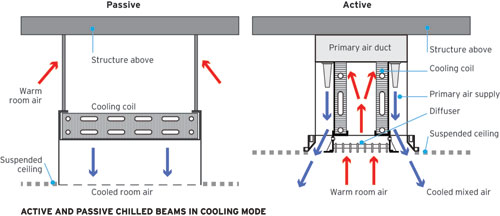An Energy-Conserving Technology From Europe Makes Inroads in the U.S.
Although the beams provide some degree of cooling by radiation, they differ from conventional radiant-cooling systems, which are often based on walls or floors chilled by embedded cold-water pipes. The latter types of systems cool occupants because heat naturally radiates from a warmer body (a person) to a cooler body (the chilled slab, floor, or other surface). Passive chilled beams, in contrast, must be high in the space because they transfer heat primarily through convection.
Without fans, passive chilled beams are virtually silent. There are no moving parts, so operational costs are lower. To top these advantages, manufacturers claim there is no sacrifice in comfort; indeed, they claim these environments are more comfortable than those served by forced, cooled air.
 |
Chilled beams are either passive or active. Both types rely on convection for cooling, but active beams are integrated with the primary ventilation air supply. Images courtesy SmithGroup |
Â
Obviously, this method of cooling does not provide any ventilation air, as VAV systems do. So ventilation is required in addition, but ducts can be smaller than usual. In applications where internal loads dominate the cooling needs, the savings on ductwork, air handlers, and fan energy can be substantial. Smaller ducts also mean that architects can design higher ceilings or lower floor-to-floor heights. The resulting savings can more than offset the initial cost of the chilled-beam units.
Because the overall ventilation volume is decreased, ventilation air can contain a higher proportion of outside air, creating a healthier indoor environment. And because there is no central air handler supplying super-cooled air, the wasteful practice of reheat is eliminated.
Chilled beams are typically not visually exposed but are covered by perforated enclosures. The units can be stand-alone, like suspended light fixtures, or they can be integrated with drop-ceiling systems.









